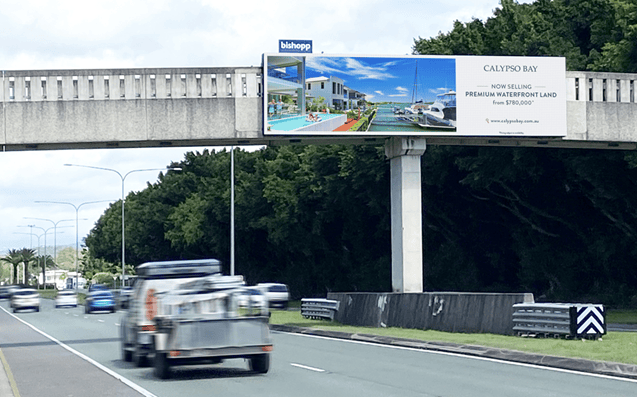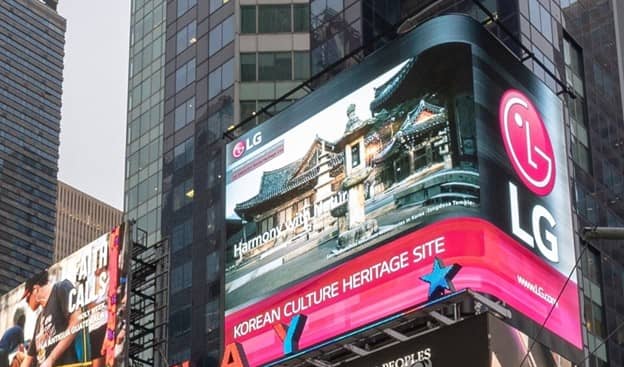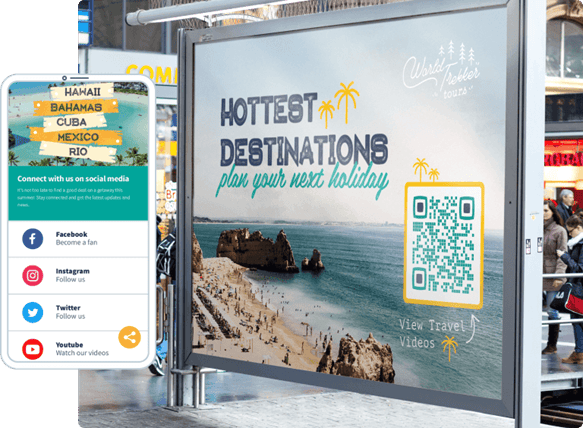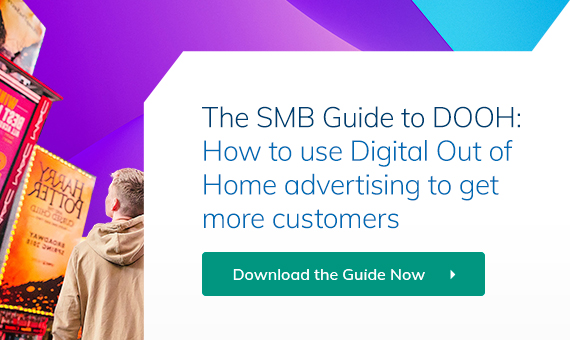In the digital age, the tourism industry has witnessed a significant shift in advertising strategies. Among the emerging trends, Digital-Out-of-Home (DOOH) advertising has become a powerful tool for tourism organizations to capture the attention of travelers. With its ability to reach a wide audience and create engaging experiences, DOOH has revolutionized how destinations promote their offerings.
DOOH refers to the use of digital screens and displays placed in public spaces to deliver advertising messages and content. It involves utilizing digital screens located in high-traffic areas such as airports, transportation hubs, popular landmarks, shopping districts and roadsides. These digital displays can include LED billboards, digital signage, interactive touch screens, or video walls and aim to effectively reach and engage with potential audiences by showcasing captivating visuals, sharing relevant information about the brand, and promoting tourist attractions, accommodations, or activities if you are a touristic destination for example. DOOH allows tourism brands to leverage the power of digital technology to create immersive and interactive experiences, enhancing their advertising efforts and influencing travelers’ decision-making processes.
With the latest digital signage solutions and programmatic DOOH (pDOOH) platforms, there are always new ways for advertisers to connect with their target audience at the right place and the right time.
Check out the following blogs to learn more about DOOH:
What Is Programmatic Digital Out of Home Advertising?
Programmatic DOOH: Why It’s a Game-Changer
DOOH Networks vs Digital Signage: What is the difference?
In this blog, we will explore the best practices for leveraging the role of Digital-Out-of-Home in tourism advertising.
1. Location, Location, Location
Choosing the right locations for DOOH displays is crucial for effective tourism advertising. Identify high-traffic areas such as airports, popular landmarks, transportation hubs and shopping districts where tourists congregate. Placing displays in strategic locations allows you to reach a larger audience and increases the chances of capturing the attention of potential visitors.

(Image source: bishopp.com.au)
Imagine you are a tropical island destination known for its pristine beaches and adventurous activities. To effectively utilize DOOH displays, you strategically select the following locations:
- Airports: Place digital displays in prominent areas of the airport, such as arrival halls, baggage claim areas, or near boarding gates. This ensures that travelers arriving at or departing from the destination are exposed to your enticing visuals, creating a strong first impression and sparking their interest.
- Popular Landmarks: Identify iconic landmarks within the destination that attract a large number of tourists. For instance, if there’s a famous lighthouse or a scenic viewpoint, position digital displays in these areas to captivate visitors while they enjoy the breathtaking views. This enables you to target an audience already interested in exploring the destination.
- Transportation Hubs: Set up DOOH displays in transportation hubs such as bus or train stations, ferry terminals, or cruise ports. Travelers passing through these hubs are often looking for information on local attractions or activities. By showcasing engaging content on your displays, you can pique their curiosity and influence their decision to explore the destination further.
- Shopping Districts: Locate digital screens in busy shopping areas, where tourists often spend time browsing stores or enjoying local cuisine. By placing displays near shopping centers, street markets, or popular restaurants, you can capture the attention of potential visitors during their leisurely moments. Showcase visuals of the island’s unique souvenirs, local delicacies, or vibrant street scenes to evoke a sense of wanderlust.
2. Storytelling through Visuals
DOOH advertising thrives on captivating visuals. Create visually appealing content that tells a compelling story about your destination. Use high-quality images and videos that showcase the unique experiences, landscapes and attractions your location has to offer. Incorporate strong branding elements to create a consistent and memorable visual identity.
Let’s imagine you are promoting a historic city known for its rich cultural heritage, architectural marvels and vibrant festivals. To create visually appealing DOOH content that tells a compelling story about the destination, consider the use of high-quality images, engaging videos, landscape showcase, unique experiences whilst ensuring consistent and strong branding elements.

(Image source: en.yna.co.kr)
3. Dynamic and Contextual Content
One of the greatest advantages of DOOH advertising is its flexibility to display dynamic content in real-time. Utilize data feeds and contextual triggers to customize your messaging based on the time of day, weather conditions, or specific events happening in the area. For example, during a music festival, you can promote local accommodation options or highlight nearby attractions to engage festival-goers.
Let’s say you are promoting a coastal city that hosts a renowned music festival every summer. To leverage the flexibility of DOOH advertising and display dynamic content in real-time, you can:
- Use data feeds to tailor your messaging based on the time of day. In the morning, showcase images of serene beach scenes with the sunrise, promoting early morning activities like beach yoga or sunrise walks. During the afternoon, highlight water sports or beachside cafes to attract visitors seeking leisurely experiences. As evening approaches, transition to images of vibrant nightlife, featuring live music venues or beachfront restaurants.
- Weather Conditions: Integrate weather data into your DOOH content to provide personalized recommendations based on the current weather. On a sunny day, display visuals of people enjoying water activities such as surfing, sailing, or sunbathing. If it’s a rainy day, promote indoor attractions like museums, art galleries, or cozy cafes where visitors can seek refuge from the weather.
- Music Festival Promotion: During the music festival, leverage contextual triggers to engage festival-goers. Display real-time updates on the festival schedule, showcasing the lineup of artists performing each day. Promote nearby accommodations, such as hotels, resorts, or vacation rentals, to cater to the influx of festival attendees. Feature local restaurants, bars, or after-parties where visitors can unwind and continue the festive spirit.
- Local Attractions: Utilize data feeds to identify popular attractions and events happening in the area. If there’s a major art exhibition or cultural festival taking place, highlight it on your DOOH displays to attract art enthusiasts or cultural travelers. Showcase nearby landmarks or natural wonders that tourists can explore during their visit, creating a sense of excitement and curiosity.
4. User Engagement and Integration with Digital Platforms
DOOH has the potential to provide interactive experiences to engage tourists on a deeper level. To maximize the impact of DOOH advertising, integrate it with your digital marketing efforts. Connect your DOOH displays with social media platforms, mobile apps, or websites to create a seamless experience for travelers. For instance, display hashtags or QR codes that allow viewers to instantly engage with your destination’s social media profiles or access exclusive offers.

(Image source: qr-code-generator.com)
5. Data-Driven Optimization
Leverage the power of data to optimize your DOOH campaigns. Monitor and analyze key metrics such as impressions, engagement rates and conversions. You have the ability to test different creatives, messages, or call-to-action strategies to refine your approach and achieve better results. This data-driven approach ensures that you can continuously optimize your campaigns for maximum impact.
In conclusion, Digital-Out-of-Home advertising has emerged as a powerful tool in the tourism industry, allowing destinations to engage with travelers in a dynamic and impactful way. By strategically selecting locations, telling captivating stories, creating interactive experiences, and integrating with digital platforms, tourism organizations can leverage the full potential of DOOH advertising. Embrace these best practices and stay ahead of the curve in attracting visitors to your destination, ultimately leading to increased tourism revenue and brand recognition.
Get Started with Programmatic DOOH Today
With The Neuron, your campaigns can be created and run via single-click processes on a dashboard that’s easy to use and navigate. You can then use the platform to track your campaign and view in-depth analytics so you can adjust and optimize in real-time.
It couldn’t be easier to get started with programmatic DOOH. Start now!


